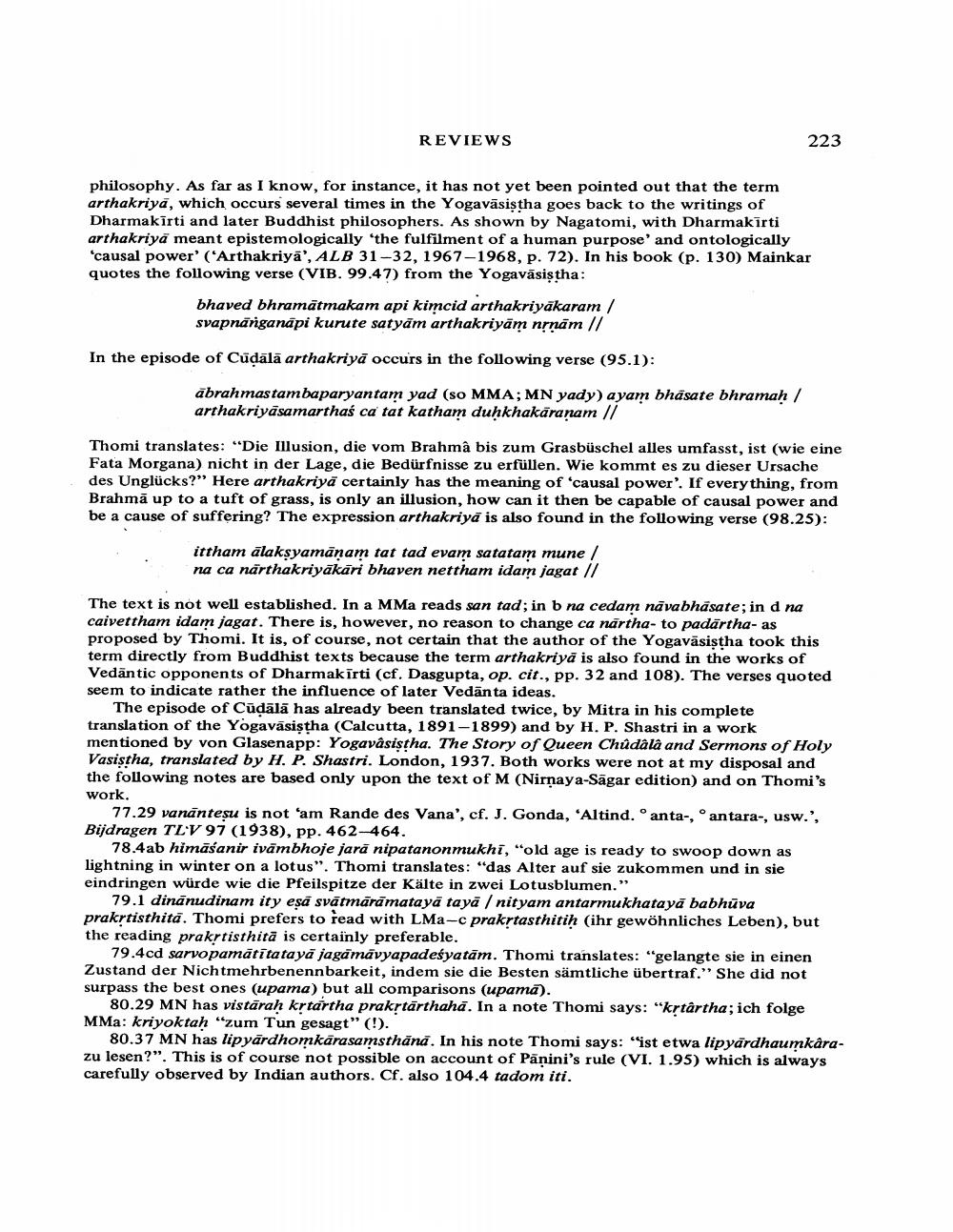Book Title: Book Reviews Author(s): J W De Jong Publisher: J W De Jong View full book textPage 5
________________ REVIEWS philosophy. As far as I know, for instance, it has not yet been pointed out that the term arthakriya, which occurs several times in the Yogavāsiṣtha goes back to the writings of Dharmakirti and later Buddhist philosophers. As shown by Nagatomi, with Dharmakirti arthakriya meant epistemologically 'the fulfilment of a human purpose' and ontologically 'causal power' ('Arthakriya', ALB 31-32, 1967-1968, p. 72). In his book (p. 130) Mainkar quotes the following verse (VIB. 99.47) from the Yogavāsiṣtha: bhaved bhramātmakam api kimcid arthakriyākaram / svapnanganāpi kurute satyam arthakriyām nṛṇām // In the episode of Cuḍālā arthakriya occurs in the following verse (95.1): abrahmastambaparyantam yad (so MMA; MN yady) ayam bhasate bhramaḥ/ arthakriyasamarthaś ca tat katham duḥkhakaranam || 223 Thomi translates: "Die Illusion, die vom Brahmâ bis zum Grasbüschel alles umfasst, ist (wie eine Fata Morgana) nicht in der Lage, die Bedürfnisse zu erfüllen. Wie kommt es zu dieser Ursache des Unglücks?" Here arthakriya certainly has the meaning of 'causal power'. If every thing, from Brahma up to a tuft of grass, is only an illusion, how can it then be capable of causal power and be a cause of suffering? The expression arthakriya is also found in the following verse (98.25): ittham alakṣyamāṇam tat tad evam satatam mune/ na ca närthakriyakari bhaven nettham idam jagat // The text is not well established. In a MMa reads san tad; in b na cedam nāvabhasate; in d na caivettham idam jagat. There is, however, no reason to change ca närtha- to padartha- as proposed by Thomi. It is, of course, not certain that the author of the Yogavāsiṣṭha took this term directly from Buddhist texts because the term arthakriya is also found in the works of Vedantic opponents of Dharmakirti (cf. Dasgupta, op. cit., pp. 32 and 108). The verses quoted seem to indicate rather the influence of later Vedanta ideas. The episode of Cūḍālā has already been translated twice, by Mitra in his complete translation of the Yogavasiṣṭha (Calcutta, 1891-1899) and by H. P. Shastri in a work mentioned by von Glasenapp: Yogavâsistha. The Story of Queen Chûdâlâ and Sermons of Holy Vasistha, translated by H. P. Shastri. London, 1937. Both works were not at my disposal and the following notes are based only upon the text of M (Nirnaya-Sagar edition) and on Thomi's work. 77.29 vananteṣu is not 'am Rande des Vana', cf. J. Gonda, 'Altind. anta-, antara-, usw.", Bijdragen TLV 97 (1938), pp. 462-464. 78.4ab himāśanir ivāmbhoje jarā nipatanonmukhi, "old age is ready to swoop down as lightning in winter on a lotus". Thomi translates: "das Alter auf sie zukommen und in sie eindringen würde wie die Pfeilspitze der Kälte in zwei Lotusblumen." 79.1 dinänudinam ity eṣa svātmāramataya taya / nityam antarmukhataya babhuva prakṛtisthita. Thomi prefers to read with LMa-c prakṛtasthitiḥ (ihr gewöhnliches Leben), but the reading prakṛtisthita is certainly preferable. 79.4cd sarvopamātītataya jagamavyapadeśyatām. Thomi translates: "gelangte sie in einen Zustand der Nichtmehrbenennbarkeit, indem sie die Besten sämtliche übertraf." She did not surpass the best ones (upama) but all comparisons (upamā). 80.29 MN has vistaraḥ kṛtartha prakṛtärthaha. In a note Thomi says: "kṛtârtha; ich folge MMa: kriyoktaḥ "zum Tun gesagt" (!). 80.37 MN has lipyardhomkarasamsthānā. In his note Thomi says: "ist etwa lipyardhaumkârazu lesen?". This is of course not possible on account of Panini's rule (VI. 1.95) which is always carefully observed by Indian authors. Cf. also 104.4 tadom iti.Page Navigation
1 ... 3 4 5 6 7 8 9 10 11 12 13 14 15 16 17 18 19 20 21 22 23 24 25 26
